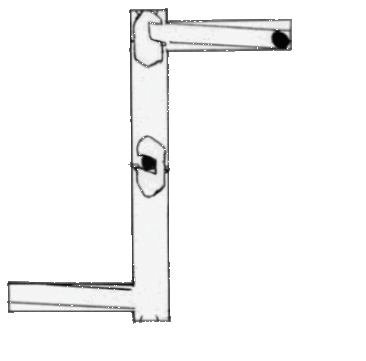Comments on the ICW engine
 As you may have already guessed, the inventor named this the "ICW engine" because
"It Can't Work".
As you may have already guessed, the inventor named this the "ICW engine" because
"It Can't Work".The buoyant carriers and lead balls can be analyzed in the same manner as Ben Mitch did for the Buoyant Engine No. 3. The feature of catches to halt the motion at crucial times and trigger releases to resume the motion may seem to compromise the performance of the machine, but we assure you that's not the case. Such interruptions would entail energy losses in a real machine. But if we could show that the motion is self-initiating after every interruption, then surely we would have achieved perpetual motion. The design could then be refined to smooth out the motion. After all, every escapement clock mechanism involves motion interruption by a ratchet, and those mechanisms achieve excellent regularity in the function of mechanical clocks.
 |
These interruptions also make the analysis easier, for the major part of the apparatus is static during the interruptions, only the balls, carriers and liquid move. These motions may then be analyzed without the necessity of dealing with centrifugal effects.
The tilted sidearms represent portions of the chord of a circle. The analysis of the balls rolling down these will depend on how much they are tilted. When the ball is at the top, the normal force of the ball on the tube wall as it enters the tube is such that it exerts a counterclockwise torque on the main apparatus. But later (if the tube is long enough, or not tilted too much, the line of action of that force will move to the other side of the axle and give a clockwise torque. When the ball is at the bottom, rolling back into its carrier, the torques produced are in the opposite sense to those at the top. Without the "catches" to prevent backward motion, these would add to zero over a complete cycle. Here we see the importance of those catches, for they ensure that the rolling balls will contribute a clockwise torque to the system, and only a clockwise torque. This is an important psychological element in leading the viewer of the animation to conclude that surely this machine will move clockwise, continually. Also, it seems, what's going on in the main tube as the buoyant carriers move the balls up and down cannot contribute torque one way or the other, since the machine is stationary while that happens. This illustrates by example why so many perpetual motion machine proposals are so seductive. They are like a magician's stage illusion, letting you see things which convince you something magical is happening while hiding from your view the things that are really happening (or not happening).
We offer these helpful comments to convince you that this machine is not trivial. But bear in mind that these comments may be part of the deception.
Return to The Annex